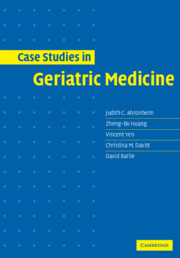Book contents
- Frontmatter
- Contents
- Preface
- 1 Annual physical
- 2 Office visit
- 3 A bad driver
- 4 Early dementia
- 5 Moderate dementia
- 6 Severe dementia
- 7 Two women with advanced dementia
- 8 Occupational deterioration
- 9 Atypical dementia
- 10 “Pseudodementia”
- 11 Chest pain
- 12 Clearance for surgery
- 13 Type 2 diabetes
- 14 Two patients with hypertension
- 15 A fall
- 16 Wheezing
- 17 Acute hemiparesis
- 18 Chronic hemiparesis
- 19 Lower gastrointestinal hemorrhage
- 20 Delirium
- 21 Herbal remedies
- 22 Insomnia
- 23 Low vision
- 24 Recurrent falls
- 25 Four patients in an osteoporosis clinic
- 26 Hip fracture
- 27 Headache
- 28 Pain
- 29 Leg ulcer
- 30 Chronic cough
- 31 Diarrhea
- 32 Upper gastrointestinal bleeding
- 33 Urinary incontinence
- 34 Urinary retention
- 35 Erectile dysfunction
- 36 Vaginal bleeding
- 37 “Mother is not herself”
- 38 “Failure to thrive”
- 39 Three hospitalized patients with agitation
- 40 Weight loss
- 41 Hypothermia
- 42 Hyperthermia
- 43 A centenarian
- Index
Preface
Published online by Cambridge University Press: 06 December 2010
- Frontmatter
- Contents
- Preface
- 1 Annual physical
- 2 Office visit
- 3 A bad driver
- 4 Early dementia
- 5 Moderate dementia
- 6 Severe dementia
- 7 Two women with advanced dementia
- 8 Occupational deterioration
- 9 Atypical dementia
- 10 “Pseudodementia”
- 11 Chest pain
- 12 Clearance for surgery
- 13 Type 2 diabetes
- 14 Two patients with hypertension
- 15 A fall
- 16 Wheezing
- 17 Acute hemiparesis
- 18 Chronic hemiparesis
- 19 Lower gastrointestinal hemorrhage
- 20 Delirium
- 21 Herbal remedies
- 22 Insomnia
- 23 Low vision
- 24 Recurrent falls
- 25 Four patients in an osteoporosis clinic
- 26 Hip fracture
- 27 Headache
- 28 Pain
- 29 Leg ulcer
- 30 Chronic cough
- 31 Diarrhea
- 32 Upper gastrointestinal bleeding
- 33 Urinary incontinence
- 34 Urinary retention
- 35 Erectile dysfunction
- 36 Vaginal bleeding
- 37 “Mother is not herself”
- 38 “Failure to thrive”
- 39 Three hospitalized patients with agitation
- 40 Weight loss
- 41 Hypothermia
- 42 Hyperthermia
- 43 A centenarian
- Index
Summary
Case Studies in Geriatric Medicine condenses a rapidly growing body of knowledge about aging and geriatric care. The intent of this volume is to reach clinicians at all levels of experience – to intercept the student before nonage-adjusted principles become too firmly imbedded, and to enhance the well-honed skills of the experienced health care provider. The case-based learning approach will propel the reader to think about the total patient, to consider the medical as well as the psychosocial, ethical, and complex interdisciplinary aspects of caring for elderly patients.
Cases are identified by the patient's symptom or syndrome, so the reader can arrive at “the right answer” through a process of question and answer. Cases are grouped by syndrome category (for example, early, moderate, and late dementia; hypothermia and hyperthermia), and categories or individual cases may be studied in or out of sequence as desired. The question and answer format will serve as a skill enhancer and a supplemental guide for geriatric certifying examinations, and hopefully will make the learning process enjoyable. Current and some “classic” references are provided throughout for additional reading.
As the body of knowledge has expanded, basic geriatrics principles have endured. Awareness of these principles is essential to the mastery of geriatric medicine.
Chronologic and biologic age are not well matched
While some people are “old at 18,” many 90-year-olds appear or act in ways that are surprisingly youthful.
- Type
- Chapter
- Information
- Case Studies in Geriatric Medicine , pp. vii - xPublisher: Cambridge University PressPrint publication year: 2005



